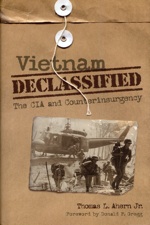The CIA’s Counterinsurgency ‘Mission Impossible’
 First published as a classified internal history in 2001, Vietnam Declassified is a detailed study of the Central Intelligence Agency’s role in rural pacification operations in South Vietnam. Author Thomas L. Ahern Jr. was a CIA operations officer for more than 30 years in East Asia, Indochina, Africa, Iran and Europe. He provides a unique narrative based on his personal experience in Vietnam and secret archives to which he had unrestricted access. The result is a meticulously documented history of the CIA’s engagement in the pacification effort in Vietnam from 1954 to mid-1972.
First published as a classified internal history in 2001, Vietnam Declassified is a detailed study of the Central Intelligence Agency’s role in rural pacification operations in South Vietnam. Author Thomas L. Ahern Jr. was a CIA operations officer for more than 30 years in East Asia, Indochina, Africa, Iran and Europe. He provides a unique narrative based on his personal experience in Vietnam and secret archives to which he had unrestricted access. The result is a meticulously documented history of the CIA’s engagement in the pacification effort in Vietnam from 1954 to mid-1972.
Ahern focuses on “the struggle to suppress the Viet Cong and win the loyalty of the peasantry” during six distinct periods, beginning with 1954 to 1956, when the CIA effort was conducted by two different and autonomous units. One was led by Colonel Edward Lansdale and focused on building security and civic action programs in the countryside. Another group, under the CIA Far East Division of the Directorate of Plans, focused on rural political mobilization. The second period, 1956-61, was characterized by President Ngo Dinh Diem’s heavy-handed attempt to eradicate the Communist elements in the countryside, which alienated a large part of the peasant population and resulted in sharply reduced agency engagement.
During the third period, 1961-63, CIA efforts aimed at testing emerging theories of counterinsurgency in an attempt to build viable village self-defense programs, including the ultimately ill-fated Strategic Hamlet program. After the coup and assassination of Diem in 1963 by a group of South Vietnamese generals, CIA efforts shifted focus in the 1963-65 time period to pacification efforts at the province level, experimenting with variations on earlier programs. The fifth period, 1966-69, was characterized by the rapid buildup of U.S. combat troops, which ultimately resulted in U.S. pacification programs being unified under the Military Assistance Command, Vietnam (MACV). The final period, 1969-75, was marked by the Nixon administration’s attempt to “Vietnamize” the war, in which the CIA-sponsored pacification programs were turned over to the South Vietnamese. During this time, according to Ahern, Saigon elected not to apply the resources necessary to promote pacification in the countryside, and the resultant deterioration of that effort contributed directly to the South Vietnamese collapse when the North Vietnamese launched their general offensive in 1975.
Ahern provides a detailed examination of the extensive effort to convince the rural Vietnamese that their best interests lay with the Saigon central government. He concludes that these efforts were fatally flawed and resulted in ultimate failure. He enumerates a number of reasons for that failure, not the least of which were false assumptions and self-inflicted cultural blindness.
In the end, the CIA was on a “mission impossible” from the very beginning, since there was never any real attempt at any level to analyze and understand the nature of the insurgency or the fundamental political dynamics among the Viet Cong, Saigon and the South Vietnamese in the countryside. Part of the problem, according to Ahern, was that the Saigon regime was hostile to any programs that might have brought even a semblance of self-government to the rural areas. He also challenges the notion that the Viet Cong’s main weapon was terror, and is critical of U.S. policies that focused on “selling the GVN [Government of Vietnam]” rather than giving the people in the countryside a viable alternative to the Viet Cong. He faults American leaders for their failure to face the possibility that no amount of U.S. support could create a viable South Vietnamese government. In the end, Ahern concludes, “The North Vietnamese tanks rolling into Saigon on 30 April 1975 sealed a victory that the Southern insurgents had won more than a decade before.”
Vietnam Declassified provides new perspectives on the CIA’s role in the American effort to win the hearts and minds in Vietnam. Not every reader will agree with some of the things Ahern posits. For example, some may find fault with his assertion that the campaign to compete with the Viet Cong in the political mobilization of the people faltered after the Tet Offensive of 1968 because of the CIA’s withdrawal from a leadership role in the pacification effort. Others have argued that some significant progress was made in the countryside during the years following Tet. Despite this and similar points of contention, Thomas Ahern has written an important book that sheds new light on the continuing debate about what worked and didn’t work in America’s nation-building programs in Vietnam. It is also very timely given the current U.S. efforts to build viable security and governance institutions in Afghanistan.




